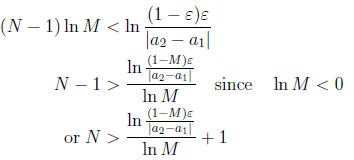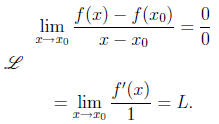1. Suppose that f is uniformly continuous on a set S
 R and
R and  is a Cauchy
sequence in
is a Cauchy
sequence in
S. Prove that
 is a Cauchy sequence. (f is not assumed to be continuous outside
is a Cauchy sequence. (f is not assumed to be continuous outside
S, so you cannot use Theorem 3.2, p. 60).
Proof. Let ε > 0. Since f is uniformly continuous on S, there exists
 > 0 such that
> 0 such that
lx - yl <  implies l f(x) - f(y) l < ε
for all x, y ∈ S.
implies l f(x) - f(y) l < ε
for all x, y ∈ S.
 (1)
(1)
For this > 0 there exists such that for n ,m > N,
such that for n ,m > N,
 . By (1) it
. By (1) it
follows that for n, m > N,
 .
Hence
.
Hence
 is Cauchy.
is Cauchy.
2. Let M > 0 and let f : D → R, D
 R, satisfy the condition
R, satisfy the condition
 for
for
all x, y ∈ D. Show that f is uniformly continuous.
Proof. Let ε > 0. Put  . Then if
. Then if
 ,
,

Hence f is uniformly continuous.
3. Suppose that for some constant M with 0 < M < 1,
 ,
,
n = 1, 2, 3,.... Prove that the sequence fang  is Cauchy.
is Cauchy.
Proof. We will first show that

This is true for n = 1 as assumed. Suppose it is true for n = k. Then

Hence (2) is true for all n.
For a fixed N and n = N + r, we have

Given ε > 0, let  . Then
. Then
 . Take logarithms .
. Take logarithms .

4. Suppose that f and g are continuous functions on the
closed interal [a, b] such that f(r) =
g(r) for every rational number r ∈ [a, b]. Prove that f(x) = g(x) for all
x ∈ [a, b].
Proof. Suppose that f(z) ≠ g(z) for some irrational number z in [a, b]. Let

α. For  , there exists
, there exists
 > 0 such that
> 0 such that
 and
and 
whenever  . Let r be a rational number with
. Let r be a rational number with
 .
Then
.
Then
f(r) = g(r). Moreover,

a contradiction. Hence f(z) = g(z) for all z ∈ [a,
b].
5. Let  .
.
(a) Show that  is
bounded and monotone.
is
bounded and monotone.
Proof. Let . Then
. Then
 for x > -1. Hence f is
for x > -1. Hence f is
increasing. Consider the point  . Then f(x*) =
x* . For
. Then f(x*) =
x* . For  = 1 < x* ,
= 1 < x* ,
 . And by induction, we have
. And by induction, we have
 . Hence
. Hence  is
bounded
is
bounded
above by x* . Since  , it follows by the same
reasoning that
, it follows by the same
reasoning that
 is monotonically increasing. Hence by the
Bolzano-Weierstran Theorem,
is monotonically increasing. Hence by the
Bolzano-Weierstran Theorem, 
must converge.
(b) Find  .
.
Proof. Let  . Then
. Then
 is the limit point as
is the limit point as
 is discarded
is discarded
since it is negative .
6. Let S be the space of all rational numbers , with d(p, q) = l p - q l, and E
is the set of all
rational numbers p such that 2 < p2 < 3. Prove that
(i) E is closed and bounded.
(ii) E is not compact.
Proof.

(a) E is clearly bounded by
 and
and  . Let x ∈ E', then
there is a sequence
. Let x ∈ E', then
there is a sequence 
in E with  → 0 as n → ∞. Now
→ 0 as n → ∞. Now
 is either in
is either in
 or
or  , say
, say
 . Hence
it
. Hence
it
either converges in I, and hence  or it converges to either
or it converges to either
 or
or  which
which
are not in our space. Hence E is closed.
(b) Consider the open cover  where
where

p2 < 3 }. This cover has not finite subcover. Hence it is not compact.
Another solution :
Take the sequence  . Then
. Then
 has no
convergent subsequences.
has no
convergent subsequences.
7. Let E be a nonempty subset of a metric space (S, d). Define the distance from
x ∈ S to
the set E by  .
.
(a) Prove that  if and only if
if and only if  .
.
(b) Prove that  : S → R is uniformly continuous on S.
: S → R is uniformly continuous on S.
Proof. (a) Let p(x) = 0. Then
 . Hence there is a sequence
. Hence there is a sequence
 in E
in E
with  → 0 as n → ∞. Thus x ∈
→ 0 as n → ∞. Thus x ∈
 . For the converse, let x ∈
. For the converse, let x ∈
 .
If x ∈ E,
.
If x ∈ E,
then as d(x, x) = 0, p(x) = 0. If x ∈ E\E, then there exists
 as
as
n → ∞ or  → 0 as n → ∞. Hence p(x) = 0.
→ 0 as n → ∞. Hence p(x) = 0.
(b) p : S → R. For 

But  or
or
 . Similarly
. Similarly
 . Thus
. Thus  .
Hence
.
Hence
 . Given ε > 0, let
. Given ε > 0, let
 = ε. If
= ε. If
 , then
, then

8. Suppose that f is continuous on an open interval I containing
 , suppose
that f' is defined
, suppose
that f' is defined
on I except possibly at  , and suppose that
, and suppose that  .
Prove that
.
Prove that  .
.
Proof.  if the limits exists. Since f is
continuous,
if the limits exists. Since f is
continuous, 
 . Now
. Now

9. Let f and g be continuous functions on [a, b], g is
positive and monotonically decreasing
and g'(x) exists on [a, b]. Prove that there exists a point
 such that
such that

Proof. Let  . Since g is
positive , either
. Since g is
positive , either

or

In either case,  is
between h(a) = 0 and h(b). By the Intermediate Value
is
between h(a) = 0 and h(b). By the Intermediate Value
Theorem, there exists  between a and b such that
between a and b such that

10. Suppose that f is continuous at x = a such that lf(a)l
< 1. Prove that there exists an
open interval  , such that for all x ∈
I, l f(x) l ≤ M < 1, for some
, such that for all x ∈
I, l f(x) l ≤ M < 1, for some
fixed constant M.
Proof. Let L = l f(a) l < 1. If such an M does not exist for any
 , there exists a
sequence
, there exists a
sequence
 that converges to a with
that converges to a with .
Since f is continuous,
.
Since f is continuous,  as
as
n → ∞. But this is not possible as  for all n.
for all n.



